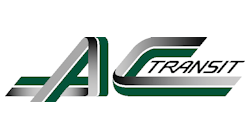AC Transit Hosts Reopening, Open House and Tour of the Richmond-Division 3 Bus Facility
The Alameda-Contra Costa Transit District (AC Transit) has unveiled its newly redesigned Richmond Division 3 bus facility. This $18 million rehabilitation project was funded largely by AC Transit’s operating funds but could not have been completed without the generous funding support from the State of California and the Federal Transit Administration.
The ribbon cutting celebration included representatives from the offices of United States Congressman Mark DeSaulnier, California Assembly Member Tony Thurmond, and California State Senator Nancy Skinner. Featured speakers included AC Transit Board President Elsa Ortiz, AC Transit Board Vice President Joe Wallace, city of Richmond Vice Mayor Jonvanka Beckles, and representatives of organized labor, regional transportation leaders and a host of community advocates. Guests participated in docent guided tours of this historic and reimagined 50,000 square foot bus division shuttered in 2011 due to the severe economic downturn in the national economy.
“The closure of Division 3 in 2011 represented one of the most difficult decisions the AC Transit Board has faced,” said AC Transit Board President Elsa Ortiz. “But much like the mythological Phoenix arose renewed, so has Division 3. Now we have a bus division that returns jobs to Richmond. It’s built with unsurpassed technology and invest Cap and Trade funds for environmentally and economically sensible approaches to our transit.”
Prudent cost controls following the 2011 closure has allowed the Macdonald Avenue landmark bus division to reopen and reconnect the history between AC Transit and the Richmond community. In fact, the city of Richmond was incorporated on August 7, 1906. Three months later, as the Bay Area rose from the ruins of the 1906 earthquake, AC Transit’s predecessor the East Shore & Suburban Railway (later assumed by the Key System) purchased four acres parallel to the railroad tracks on Macdonald Avenue. The development served as the region’s first fully equipped car barn. By the 1930’s, the car barn had become a bus facility to service the region’s first bus only line. The number of bus lines quickly grew, cementing the Macdonald Avenue site as the birthplace of public transportation in West Contra Costa County.
“Reopening Division 3 helps alleviate capacity concerns at other bus divisions and is a positive advancement toward meeting our goal to respond to increasing ridership districtwide,” said AC Transit General Manager, Michael Hursh. “I am incredibly proud that our staff has diligently worked to reengineer service from a yard we affectionately refer to as D3. Ultimately, D3 will play a pivotal role in AC Transit’s unprecedented service expansion known as AC Go.”
AC Go was launched in July 2016 and represents a year-long initiative to increase overall bus service by nearly 14 percent. Division 3 will augment AC Go by adding:
- 105 bus operators (at full launch);
- 71 operating routes (at full launch);
- Operationally supported by 18 journey-level mechanics.
The reimagined Division 3 will feature 15 new maintenance bays, inspection pits, tire shop, and a cache of ecologically sustainable design advancements including:
- Low Flow Bus wash – This energy efficient bus wash includes a revolutionary internal water recycling system capable of recycling and reusing all of the water used to wash our buses.
- Industrial Waste Water System – Division 3 employs two Nova-Chem industrial waste-water treatment systems, which treat the waste water flow from the chassis wash, fuel island and interior maintenance bay areas. The Nova-Chem is also a backup treatment system to the internal water recycling system at the Bus wash.
- Storm Water Treatment System – Designed by stormwaterRx of Portland, Oregon the system separates and then filters storm water flows before water is released to the city of Richmond collection system. The system uses an innovative approach to pre-treat the most contaminated storm water runoff and then filters the flow with the simplicity and reliability of a sand-filtration system to treat 300 gallons of storm water per minute.
- High Efficiency, Low Emissions Emergency Generator – Division 3 has a new, very quiet emergency backup generator capable of powering all vital systems in the event of a power outage. The modern engine design and emissions equipment provide high-yield power generation efficiency with very low exhaust emissions.
Division 3 also incorporates low flow restroom fixtures, high-efficiency HVAC, dynamic improvements to operator work spaces, and industry leading communication upgrades to name a few.
To optimize Division 3’s integration into existing revenue bus service and maintain efficiencies, staffing and service additions will occur over two separate phases. The first phase will be February 6, 2017. The second and final phase is scheduled for late March.

